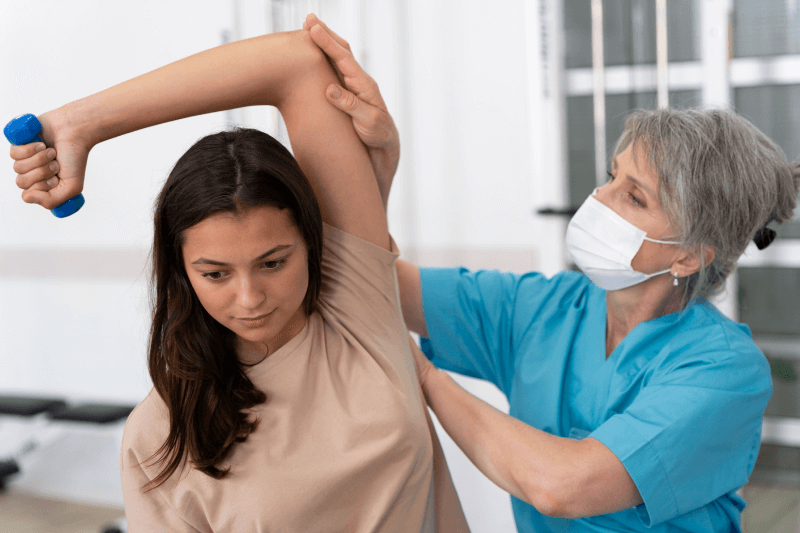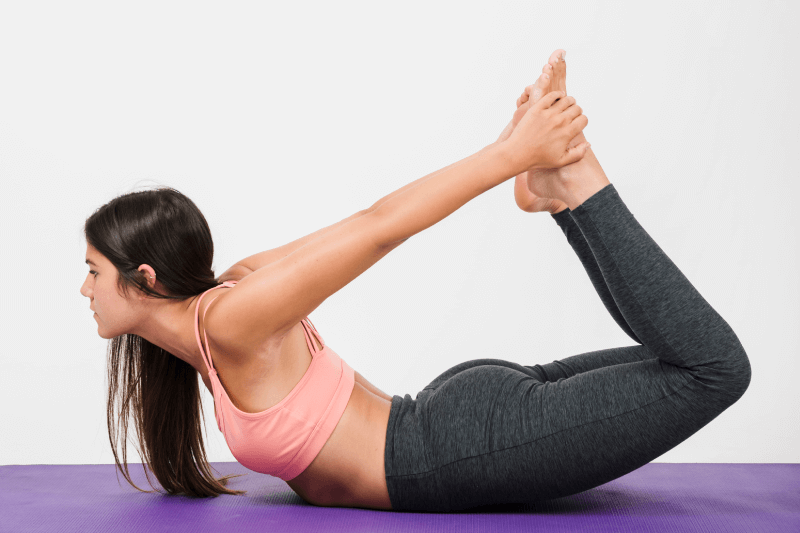In the body, the shoulder joint has the utmost potential to carry out activities such as swinging, lifting, and reaching in a wide range of motion. This makes it one of the most versatile and functional joints in the human body but also increases the risk of shoulder injury. Injuries can occur during sports activities or heavy lifting, potentially leading to shoulder dislocation. Repeated dislocations can result in lifelong shoulder instability.
Shoulder surgery is often performed to regain the range of motion, enabling individuals to resume normal activities. After surgery, it is recommended that individuals undergo post-operative physiotherapy care such as regular exercises and treatments, which facilitate shoulder healing.
To get back your movement and start doing normal things again, it’s important to follow recovery instructions. Keep reading to learn more about types, benefits and exercises to do after shoulder surgery.
Ready to regain strength and mobility post-surgery? Schedule your personalized physiotherapy session today!
Book AppointmentA] What Are The Most Common Types Of Shoulder Surgeries?
1. Rotator Cuff Repair
When you overuse your shoulders with repetitive movements, aggressive sports activities, or heavy lifting, it can strain them. This strain, in turn, can lead to tears in the rotator cuffs, a group of muscles surrounding the shoulder. Despite being connected as a unit to the upper arm bone, each component of the rotator cuff can tear independently. Due to these factors, rotator cuff injuries are quite common.
2. Shoulder Dislocation
Shoulder injuries, often caused by accidents, sports, falls, or even seizures and electric shocks, can lead to dislocation. This occurs when the upper arm bone slips out of its socket, resulting in intense pain and instability. Surgery is frequently necessary to repair torn ligaments, providing stability.
3. Arthroscopy For Frozen Shoulder
Arthroscopy is typically performed when conservative treatments such as physical therapy and medication have failed to provide relief. During this procedure, small incisions are made in the shoulder, through which a tiny camera called an arthroscope is inserted. This camera allows the surgeon to visualise the inside of the shoulder joint. Using specialized instruments, the surgeon can then release tight tissues, remove scar tissue, and manipulate the shoulder joint to improve range of motion and reduce stiffness.
4. Labrum Repair
Labrum repair shoulder surgery is a procedure aimed at fixing tears or damage to the labrum, which is a ring of cartilage that surrounds the shoulder socket. This surgery is typically performed when the labrum is torn due to injury or overuse. During the procedure, the surgeon accesses the shoulder joint and repairs the torn labrum using sutures or anchors to reattach it to the bone. This helps restore stability and function to the shoulder joint, alleviating pain and improving range of motion.
B] What Are The Benefits Of Physiotherapy After Shoulder Surgery?
1. Pain Management
Physiotherapy after shoulder dislocation plays a crucial role in managing pain effectively. Physical therapists create tailored exercise programs to strengthen shoulder muscles and reduce discomfort. Patients learn proper arm movements to prevent muscle strain. Additionally, therapists may incorporate heat or ice therapy, stretching, and gentle exercises to alleviate pain without medication reliance.
2. Improved Range of Motion
Physical therapy for shoulder surgery facilitates improved range of motion in the shoulder joint through targeted interventions. These interventions aim to restore and enhance flexibility, allowing for better movement. By implementing specific exercises and techniques, physiotherapy helps patients regain the ability to move their shoulders more freely, improving overall flexibility and mobility. This improved range of motion allows individuals to perform daily activities with greater ease and comfort, contributing to a better quality of life post-surgery.
3. Strengthening Muscles
Physio after shoulder surgery makes the muscles stronger, especially the rotator cuffs. These muscles help keep the shoulder stable and support its movements. Physiotherapy uses exercises and workouts tailored to gradually make these muscles stronger. By doing this, it helps lower the chances of future injuries like strains or tears. Strengthening these muscles makes it easier to do daily tasks and activities without hurting the shoulder.
4. Faster Recovery
Physiotherapy is like a speed boost for healing, helping patients get back to their regular routines sooner. Through exercises and specialized treatments, it kickstarts the body’s recovery process. It improves blood flow, reduces swelling, and strengthens muscles, making them more flexible. With a personalised plan from a physiotherapist, patients can regain their strength and mobility faster, allowing them to return to their daily activities smoothly and with less delay.
5. Functional Restoration
Physiotherapy is all about helping patients get back to doing their everyday activities without feeling any pain or discomfort. Exercises and treatments, make the body work better and move more easily. By strengthening muscles, making them more flexible, and teaching better ways to move, physiotherapy helps people do things like walking, reaching, or lifting without any trouble. This means they can get back to their normal routines and enjoy life without any discomfort.
6. Reduced Risk Of Complications
Physiotherapy after shoulder surgery lowers the chance of problems. Doing exercises and therapy as advised by a physiotherapist reduces the risk of complications. By following this structured plan, patients can tackle issues like stiffness and weakness, preventing complications such as frozen shoulder or muscle loss. Physiotherapy helps healing go smoothly, making recovery easier and reducing the need for further treatment.
7. Personalised Care
Physiotherapy offers customised treatment plans to suit the unique requirements and recovery goals of each patient. Dr Sameera, a leading Physiotherapist in Mumbai, often provides customised treatment plans and her team always takes the individualised approach promising that every individual receives the most appropriate care for their specific condition. By adapting exercises and therapies to address each patient’s needs, physiotherapists provide targeted support to optimize healing and improve overall well-being. This personalised attention not only fosters trust and confidence but also increases the effectiveness of the rehabilitation process, promoting better outcomes for patients.
Further Read: PhysioTherapy For Arthritis
C] Physio Exercises After Shoulder Surgery
1. Pendulum Stretch
Firstly, find a comfortable spot where you can either stand or sit. If you’re sitting, make sure to lean over a table and rest your other arm on it for support. Then, let your sore arm hang down naturally. Begin by gently swinging it in small circles, first clockwise and then counterclockwise. As you go along, feel free to gradually increase the size of the circles. This simple movement helps loosen up your shoulder, making it easier to move and reducing stiffness after surgery.
2. Shoulder Blade Squeeze
Whether you’re sitting or standing, it’s important to maintain good posture. Imagine holding a pencil between your shoulder blades, and gently squeezing them together. Hold this position for a few seconds, then relax. Repeat this movement several times. By doing this exercise regularly, you can strengthen the muscles between your shoulder blades, which helps improve posture and stability in your shoulders.
3. Passive Shoulder Flexion
Lie on your back and place a small towel or pillow under your operated arm for support. Then, use your other arm to gently lift your operated arm up until you feel a gentle stretch. Hold this position for a few seconds, allowing your shoulder to relax into the movement. After that, slowly lower your arm back down. Repeat this exercise regularly as your physiotherapist instructs to improve the flexibility and mobility of your shoulder.
4. External Rotation Stretch
Stand beside a door frame or a corner of a wall. Next, place the hand of your operated arm on the frame at shoulder height, with your elbow bent at a 90-degree angle. Then, gently lean forward, letting your body turn away from the frame to stretch your shoulder. Hold this position for about 15 to 30 seconds, allowing your muscles to relax into the stretch. Afterwards, relax and repeat the exercise on the other side if necessary. This stretch helps improve flexibility and mobility in your shoulder muscles.
5. Isometric Shoulder Strengthening
To perform the Isometric Shoulder Strengthening exercise, start by sitting or standing with good posture. Next, place a towel roll or small pillow between your hands. Then, press your hands together, engaging the muscles around your shoulder. Hold this position for about 5 to 10 seconds, feeling the muscles working. Afterwards, relax and repeat the exercise several times. This exercise helps strengthen the muscles around your shoulder, improving stability and reducing the risk of injury.
6. Wall Climbing
Begin by standing facing a wall with your fingers pointing upwards. Then, slowly walk your fingers up the wall as far as feels comfortable, keeping your arms straight. Hold this position for a few seconds, feeling the stretch in your shoulder muscles. After that, gently walk your fingers back down the wall. Repeat this movement for several repetitions to help improve flexibility and strength in your shoulders.
7. Shoulder Flexion with Broomstick
Hold a broomstick with both hands, palms facing down. Then, gradually lift the stick overhead with both arms, keeping them straight. Once you reach the top, slowly lower the stick back down behind your head, maintaining control throughout the movement. Repeat this exercise for several repetitions to strengthen the muscles in your shoulders and improve flexibility.
Ready to regain strength and mobility post-surgery? Schedule your personalized physiotherapy session today!
Book AppointmentConclusion
Physiotherapy for shoulder pain is important for successful recovery after shoulder surgery. It helps patients regain strength, flexibility, and full use of their shoulder, minimizing pain and stiffness along the way. Through a combination of exercises, manual therapy, and education, physiotherapy equips patients to return to their daily activities and even sports with confidence.
Book an appointment today with a qualified physiotherapist to discuss your recovery goals.



